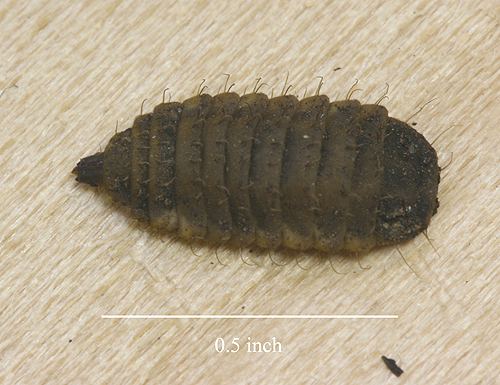One of the strangest insects encountered around the home is the larva of the stratiomyid (strat tee oh MY id), or soldier, fly. The larval form of the soldier fly is a segmented, maggot-like creature that can be quite alarming to the uninitiated. Both the larva and the adult, however, are harmless.
The most common species of soldier fly, Hermetia illucens, is commonly considered a filth fly because of its habit of breeding in manure and garbage. The feeding habits of the larva, however, are not easy to classify. The larval stage of the soldier fly feeds on decaying organic material including manure and very moist, rotting vegetable matter. In manure piles these insects are sometimes considered beneficial because they prey on other insects, like house flies. They are frequently found in compost piles and are being sold by at least one manufacturer for use in specially designed containers to quickly decompose kitchen waste (similar to earthworms in earthworm bins). Occasionally, soldier flies infest animal carcasses. Infestations in homes sometimes occur after a bee’s nest has been exterminated in a wall or other inaccessible site. This is because soldier fly larvae are one of several insects that may scavenge waste materials in bee combs.
Identification
Soldier flies are most commonly seen during their pre-pupal stage. Pre-pupal larvae are fully grown larvae that have stopped feeding and begun a time of wandering before pupating (changing into an adult, or in this case the fly, form). During this wandering phase, larvae may travel several yards from the breeding site, and may be seen wriggling along a floor, patio, or fireplace hearth. Soldier fly larvae are about one inch-long, legless, dark brown in color, and flattened. The “skin” is has a distinctive, leathery texture. Soldier fly larvae are also remarkably tough. They are able to survive for weeks in a jar with no food or water.
The adult stage of the most common species of soldier fly is about 3/4 inch-long and black, with a translucent segment on the tail, or abdomen. Adult flies are rather sluggish until induced to fly. They may be attracted to light, but do not seem attracted to food.
Damage
Soldier flies are harmless to people, and serve a beneficial role in helping decompose garbage and filth. In some places they even help control more noxious insect pests, like house flies. However, their presence in a home is usually undesirable and may be a symptom of an unsanitary situation.
Poorly maintained compost piles; spilled, wet grain; or other decaying vegetable material may provide breeding sites for soldier flies. A dead bird or rodent in an attic or chimney may also be the reason for soldier fly or blow fly infestations. Bee nests that have been allowed to live in a wall void or eave of a home can also be a source of these pests.
Control
The best control for this insect is to locate and eliminate the soldier fly’s breeding source. The larvae themselves are harmless and can be picked up by hand, or with a tissue, and discarded. Adult soldier flies can be killed with a fly swatter. If flies become numerous, an aerosol insect spray containing pyrethrins will kill most adults.
Author:
Michael Merchant, Ph.D., Professor and Extension Urban Entomologist, Texas AgriLife Extension Service

